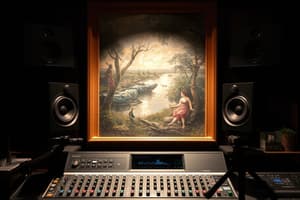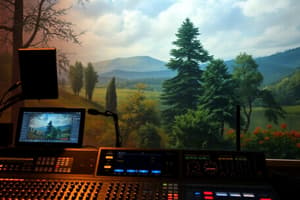Podcast
Questions and Answers
What is the recommended peak level for tracks to keep headroom in mixes?
What is the recommended peak level for tracks to keep headroom in mixes?
- -10dB (correct)
- -3dB
- -15dB
- -6dB
When recording a real drum kit, what technique can be used to eliminate space between hits on tom mics?
When recording a real drum kit, what technique can be used to eliminate space between hits on tom mics?
- Using subgrouping
- Freezing the track
- Gating the mics (correct)
- Bouncing the track
What is the purpose of muting or deleting unwanted sections, such as chair squeaks or finger noise, in a recording?
What is the purpose of muting or deleting unwanted sections, such as chair squeaks or finger noise, in a recording?
- To eliminate background noise (correct)
- To create empty spaces in the track
- To add variation to the track
- To reduce the file size
What is considered the most enjoyable part of the recording process for the author?
What is considered the most enjoyable part of the recording process for the author?
What is a crucial factor influencing how smoothly a mixing session will proceed?
What is a crucial factor influencing how smoothly a mixing session will proceed?
What is the focus of Mike Senior's contribution in this issue of Sound On Sound?
What is the focus of Mike Senior's contribution in this issue of Sound On Sound?
Which process is crucial for achieving a good vocal recording?
Which process is crucial for achieving a good vocal recording?
What is essential for a good mix at the recording stage?
What is essential for a good mix at the recording stage?
What is the purpose of using compression in audio production?
What is the purpose of using compression in audio production?
What is the purpose of filtering out some low end from a reverb in a mix?
What is the purpose of filtering out some low end from a reverb in a mix?
Why should bass sounds and lead vocals typically stay pinned to the centre of a mix?
Why should bass sounds and lead vocals typically stay pinned to the centre of a mix?
How does mastering generally impact the overall tonal balance of a mix?
How does mastering generally impact the overall tonal balance of a mix?
Which type of EQ adjustment is generally recommended to address issues in a mix?
Which type of EQ adjustment is generally recommended to address issues in a mix?
What is the primary consideration when using distortion on a sound?
What is the primary consideration when using distortion on a sound?
What is the main purpose of using high and low cut filters on specific instruments?
What is the main purpose of using high and low cut filters on specific instruments?
Flashcards are hidden until you start studying
Study Notes
- Acoustic instruments like the guitar have a wide frequency range, while triangles have a limited one.
- Parametric EQs and filters are used to adjust spectral balance in mixes and individual elements.
- Equalization (EQ) should be used mindfully to fix issues, sweeten sounds, or introduce creative effects.
- Cuts in the frequency spectrum are usually more natural and effective than boosts.
- Narrow-spectrum instruments are easier to place in a mix, while broad-spectrum sounds might need filtering or placement adjustments.
- Distortion adds harmonics to the sound, affecting the mid-range and requiring careful consideration.
- The mid-range is the most sensitive part of the spectrum, where our ears are most sensitive and where many instruments overlap.
- High and low cut filters can be used to trim unwanted frequencies and narrow the frequency range of specific instruments.
- Create space between notes and phrases to allow mix elements to sit better.
- Use reference mixes to understand what sounds work in your genre and learn from them.
- Not all equalizers sound the same, so experiment with different options to find the most musical sound.
- Convolution reverbs can sound great on acoustic instruments, but the choice of reverb type depends on personal preference.
- Use reverb judiciously, avoiding adding it to bass sounds or kick drums and leaving enough space between the notes in the mix.
- Set reverb levels conservatively and check them in both mono and stereo.
Studying That Suits You
Use AI to generate personalized quizzes and flashcards to suit your learning preferences.





